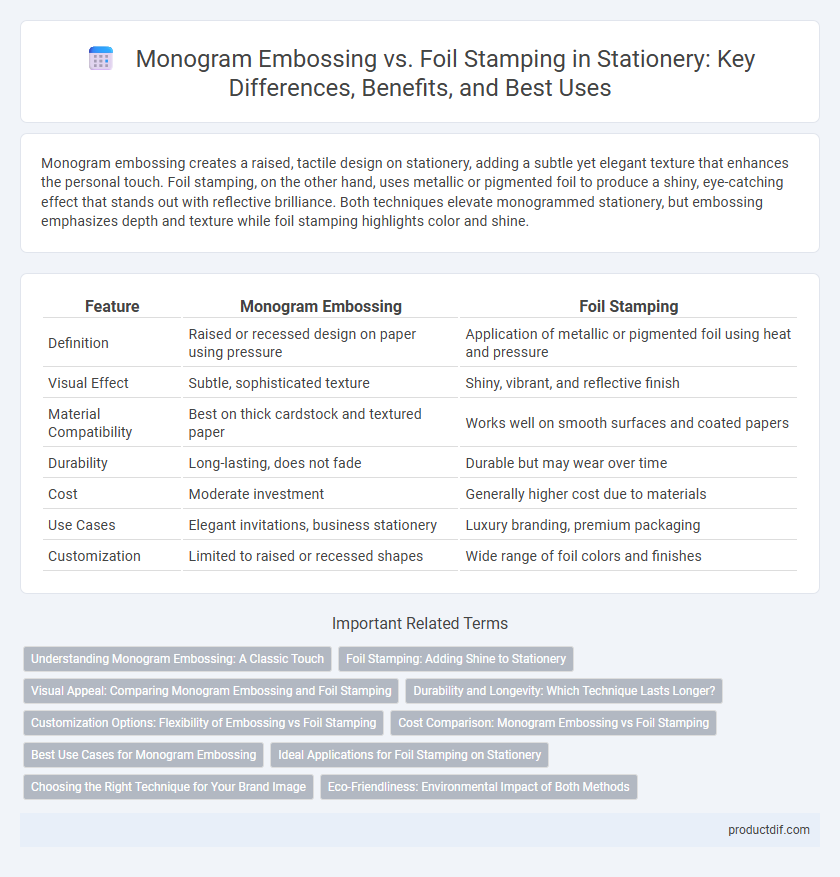Monogram embossing creates a raised, tactile design on stationery, adding a subtle yet elegant texture that enhances the personal touch. Foil stamping, on the other hand, uses metallic or pigmented foil to produce a shiny, eye-catching effect that stands out with reflective brilliance. Both techniques elevate monogrammed stationery, but embossing emphasizes depth and texture while foil stamping highlights color and shine.
Table of Comparison
| Feature | Monogram Embossing | Foil Stamping |
|---|---|---|
| Definition | Raised or recessed design on paper using pressure | Application of metallic or pigmented foil using heat and pressure |
| Visual Effect | Subtle, sophisticated texture | Shiny, vibrant, and reflective finish |
| Material Compatibility | Best on thick cardstock and textured paper | Works well on smooth surfaces and coated papers |
| Durability | Long-lasting, does not fade | Durable but may wear over time |
| Cost | Moderate investment | Generally higher cost due to materials |
| Use Cases | Elegant invitations, business stationery | Luxury branding, premium packaging |
| Customization | Limited to raised or recessed shapes | Wide range of foil colors and finishes |
Understanding Monogram Embossing: A Classic Touch
Monogram embossing creates a raised, tactile design on stationery, offering a subtle and elegant texture that enhances the paper's sophistication. This classic technique uses pressure to imprint initials or logos, providing a timeless, understated look without the use of ink or foil. Its refined appearance is ideal for formal invitations, personalized stationery, and luxury branding, emphasizing quality and tradition.
Foil Stamping: Adding Shine to Stationery
Foil stamping enhances stationery by applying metallic or pigmented foil using heat and pressure, creating a shiny and luxurious finish that stands out. This technique offers vibrant color options and reflective surfaces, making invitations, business cards, and notebooks visually appealing and professional. Foil stamping's durability ensures that designs remain crisp and luminous over time, adding a premium touch to personalized stationery products.
Visual Appeal: Comparing Monogram Embossing and Foil Stamping
Monogram embossing creates a subtle, tactile effect by pressing a design into paper, offering a sophisticated and elegant appearance that enhances texture without adding color. Foil stamping uses metallic or pigmented foil to produce a shiny, reflective finish that catches light and draws immediate attention, resulting in a bold and luxurious look. Both techniques elevate stationery aesthetics, with embossing emphasizing depth and refinement, while foil stamping highlights vibrant color and visual impact.
Durability and Longevity: Which Technique Lasts Longer?
Monogram embossing creates a raised impression on stationery, offering subtle elegance with high durability that resists fading over time. Foil stamping applies a metallic or pigmented layer onto the surface, producing vibrant colors but may show wear and cracking with frequent handling. For long-lasting impressions, embossing generally outperforms foil stamping in terms of longevity and resistance to environmental damage.
Customization Options: Flexibility of Embossing vs Foil Stamping
Monogram embossing offers deep customization through varying depths and textures, creating a subtle yet tactile impression ideal for understated elegance on stationery. Foil stamping provides vibrant color choices and metallic finishes, allowing for eye-catching designs with reflective properties that enhance visual appeal. While embossing excels in minimalistic sophistication, foil stamping delivers versatile color flexibility for bold, decorative monograms.
Cost Comparison: Monogram Embossing vs Foil Stamping
Monogram embossing typically incurs lower costs than foil stamping due to the absence of metallic foils and fewer production steps, making it an economical choice for personalized stationery. Foil stamping involves added expenses from foil materials and heat application, raising the overall price per item, especially in small runs. For bulk orders, embossing offers significant savings, while foil stamping provides a premium finish that may justify its higher cost depending on budget and design preferences.
Best Use Cases for Monogram Embossing
Monogram embossing is ideal for creating a subtle, elegant texture on stationery, perfectly suited for wedding invitations, personalized letterheads, and luxury business cards. This technique enhances tactile appeal without overpowering the design, making it a preferred choice for high-end branding and formal correspondence. It excels in adding a sophisticated, timeless touch that complements minimalist or classic aesthetics.
Ideal Applications for Foil Stamping on Stationery
Foil stamping on stationery is ideal for creating luxurious invitations, business cards, and personalized letterheads that require a striking metallic finish. This technique excels in highlighting logos, monograms, and decorative elements with vibrant gold, silver, or custom-colored foils, enhancing visual appeal and tactile experience. Foil stamping is perfect for premium wedding invitations, high-end corporate branding, and special event announcements where elegance and sophistication are paramount.
Choosing the Right Technique for Your Brand Image
Monogram embossing offers a subtle, textured effect that conveys elegance and sophistication, ideal for brands seeking a classic, understated look. Foil stamping delivers vibrant, metallic finishes that capture attention and exude luxury, perfect for brands aiming to make a bold, premium statement. Selecting between these techniques depends on your brand's personality and the impact you wish to create on stationery items.
Eco-Friendliness: Environmental Impact of Both Methods
Monogram embossing uses pressure to create raised designs without chemicals or inks, making it a highly eco-friendly choice that generates minimal waste and energy consumption. Foil stamping involves heat and metallic foils, which often contain non-recyclable materials and require solvents, contributing to greater environmental pollution. Choosing monogram embossing over foil stamping significantly reduces ecological footprint, aligning with sustainable stationery practices.
Monogram Embossing vs Foil Stamping Infographic

 productdif.com
productdif.com